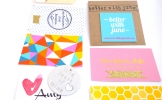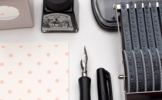Being an owner of an indie business means people expect your company’s image to match the creativity of your product. This doesn’t leave much leeway for a hastily-made logo created in Microsoft Paint.
Follow this step-by-step process of creating a logo to adorn your marketing and promotional materials, and your customers will see that you're worth the splurge of buying handmade:
An indie business logo is comprised of four parts — the font, the colors, the image and the background. These parts must be designed with each other in mind to create a final product with aesthetics in agreement.
1. THE FONT
The first step in the process of creating a logo is to choose your font, or typeface. Ideally, you should only have two fonts that you use on any materials related to your indie business. One should be simple, readable and used when writing something more long-form, when a stylized font is not appropriate. An example of this would be a press release. The other font should be equally as simple and readable, but can be jazzy as it will be used in the logo.
There are two kinds of fonts: sans-serif and serif. Serif means the font has the extensions on the end of the stroke and sans-serif means it doesn’t — think Times New Roman versus Arial. The font for your logo should be in serif agreement with the one you select to use in the long form materials. Most importantly, these fonts should be readable. Recently, my eyes strained to read a “Now Hiring” sign in Curlz-- not exactly the best way to attract job applicants. The same can be said for your indie business logo font.
2. THE COLOR
Like fonts, not all colors are meant to co-exist in your logo. Remember that color wheel from third grade art class? It shows complimentary colors and that’s a good place to start thinking about corresponding colors as you go through the process of creating a logo. Red pairs with green, yellow with purple and blue with orange. While you may not want to stick to the primary and secondary colors, it’s still smart to pair up variations of those colors. And black and white is always a staple pair.

How To Build an Artist Website
Sign up for our newsletter and get the book How to Build an Artist Website for free!
3. THE IMAGE
Unfortunately, the options for an image to fit your indie business logo could take any number of routes. You could pull an image of the initials of your company, a symbol of your product or a completely random unrelated original image. From hand-drawn designs to photographs and computer-generated graphics, the choice is yours. But, please keep it simple. You need to be able to have an image that translates from business cards to large scale signage and still looks good.
4. THE BACKGROUND
White seems to be the common background choice. Indie business logos should be simple,so this is a wise move; however, if you find a background image that’s in compliance with your image, your fonts and your colors, then by all means, use it. Changing the opacity to make it faded allows your image and type to still jump off the page.
5. PUT IT TOGETHER
A bad logo is much worse than no logo at all, so when in doubt just use a conservative typeface for your business name. However a great logo can make your website and brand look legit! Consider hiring a graphic designer for a couple bucks (literally) at fiverr.com. But if you’re a DIY enthusiast, you might try it yourself with this process of creating a logo at looka.com. You can create a beatiful brand yourself at Looka, you don't need their annual pricing plan but $65 for a one time download is a great deal for the brand quality.




